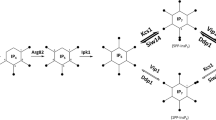Summary
A sorbose-resistant double mutant sor r A-10/sor r C-17 produces larger colonies in sorbose containing test-medium than the respective single mutants; wildtype colonies remain very small. Resistance of the single mutants was shown to be connected with a decreased rate of sorbose-uptake into their conidia; however, sorbose uptake of the double mutant had not been measured. To check, whether the improved performance of the double mutant on test medium is correlated with a further decrease of sorbose uptake in this strain, studies on the uptake of fructose, sorbose and deoxyglucose by ungerminated conidia of the two single mutants, the double mutant and the wildtype were conducted, using C14-marked sugars, the millipore filter technique, and conidia either untreated or pretreated with 1% sorbose for 4 hours.
If sorbose uptake is referred to that of fructose as basis of calculations, as in the earlier studies, the sorbose uptake by cells of the double mutant is smaller than that of both single mutants for conidia not pretreated with sorbose (Fig. 7a). However, for conidia pretreated with sorbose, this correlation does not hold. Rather, cells of the double mutant take up less sorbose than those of the C-mutant, but as much or slightly more than those of the A-mutant (Fig. 7b). If sorbose uptake is referred to that of deoxyglucose for an independent point of reference, cells of the double mutant take up less sorbose than those of the C-mutant, but much more than those of the A-mutant. This holds for untreated and sorbose pretreated cells (Fig. 5 a and b). These data rule out a correlation between colony size and transport defect for at least one of the strains used here, i.e. the C-mutant.
The following data suggest a new interpretation: In contrast to the earlier findings with germinated conidia, ungerminated untreated cells of the C-mutant take up much more fructose and sorbose than those of the wildtype (Fig. 3 a and 1a). The uptake of fructose by cells of the C-mutant can not be improved by sorbose pretreatement (Fig. 3 b), but in both wildtype and A-mutant it is increased (Figs. 1b and 2b). Uptake of deoxyglucose was nearly equal for all three strains either untreated or pretreated. Untreated cells of the A-mutant take up as much sorbose as those of the wildtype (Figs. 2 a and 1 a). On pretreatment their sorbose uptake remains nearly constant (Figs. 2b), in contrast to wildtype cells, where it increases drastically and without an increase of fructose uptake by an equivalent amount (Fig. 1b).
The new interpretation suggests that gene C is of the regulator type. Mutation of it in the C-strain used here has lead to the simultaneous de-repression of a system for fructose and sorbose uptake. Deoxyglucose uptake is not served by this system. Gene A is a structural gene, harbouring the information for the inducible synthesis of a carrier or permease specifically engaged in sorbose uptake. It is not under the controll of gene C.
This interpretation is supported by results on untreated cells of the double mutant. However, fructose uptake of such cells is roughly equal to that of C-mutant cells (Fig. 6a) and sorbose uptake is less (Fig. 5a). Hence, a secondary effect of the A-gene, i.e. on the amount of de-repression of sorbose uptake by mutation in gene C, is indicated.
Similar content being viewed by others
Literatur
Klingmüller, W.: Aktive Aufnahme von Zuckern durch Zellen von Neurospora crassa unter Beteiligung eines enzymatischen Systems mit Permeaseeigenschaften. I. und II. Z. Naturforsch. 22b, 181–188 u. 188–195 (1967 a und b).
—: Die Aufnahme der Zucker Sorbose, Fructose und Glucose durch sorboseresistente Mutanten von Neurospora crassa. Z. Naturforsch. 22b, 327–335 (1967c).
—: Kreuzungsanalyse sorboseresistenter Mutanten von Neurospora crassa. Molec. Gen. Genetics 100, 109–116 (1967d).
—: Analyse der Sorbose-Resistenz von Neurospora crassa an Heterokaryen sorboseresistenter Mutanten; ein Beitrag zur Genetik des aktiven Transports. I. Molec. Gen. Genetics 100, 117–139 (1967a).
—: Analyse der Sorbose-Resistenz von Neurospora crassa an Doppelmutanten; ein Beitrag zur Genetik des aktiven Transports, II. Molec. Gen. Genetics 100, 256–263 (1967f).
Klingmüller, W., Kaudewitz, F.: Permease mutants in Neurospora crassa and their complementation characteristics. Proc. Symp. Mutational Process, p. 309–315, Academia Prague (1966a).
—: Genetische und biochemische Untersuchungen zur Zuckeraufnahme keimender Conidien von Neurospora crassa. Ber. dtsch. bot. Ges. 79, 213 (1966b).
—: “No-growth”-complementation in forced heterocaryons from sorbose-resistant (transport-defective) Neurospora crassa mutants. Z. Naturforsch. 22b, 1024–1027 (1967).
Serres, F. J. de, Kølmark, H. G., Brockman, H. E.: Factors influencing the survival of Neurospora crassa conidia in sorbose-sucrose media. Nature (Lond.) 193, 556–557 (1962).
Vogel, H. J.: Microbial Genet. Bull. 13, 42–43 (1956).
Author information
Authors and Affiliations
Additional information
Angenommen von W. Gajewski
Rights and permissions
About this article
Cite this article
Klingmüller, W., Huh, H. & Kaudewitz, F. Regulierende Wirkung des Gens C der Sorbose-Resistenz von Neurospora crassa auf den Zuckertransport. Molec. Gen. Genetics 109, 27–41 (1970). https://doi.org/10.1007/BF00334044
Received:
Issue Date:
DOI: https://doi.org/10.1007/BF00334044



